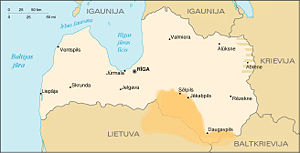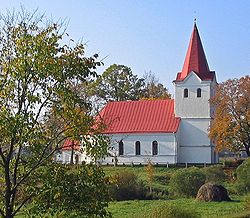
Selonia
Encyclopedia

Jekabpils
Jēkabpils is a city in Selonia, Latvia roughly halfway between Riga and Daugavpils. The Daugava River runs through the town, and the ancient valley, branches, and islands of the river are considered picturesque...
.
Not an administrative division in modern Latvia, Selonia currently contains the municipalities of Aknīste
Aknīste municipality
Aknīste municipality is a municipality in Selonia, Latvia. The municipality was formed in 2009 by merging Aknīste town with its countryside territory, Asare parish and Gārsene parish the administrative centre being Aknīste....
, Ilūkste
Ilūkste municipality
Ilūkste municipality is a municipality in Selonia, Latvia. The municipality was formed in 2003 by merging Pilskalne Parish, Šēdere Parish, Bebrene Parish and Ilūkste town...
, Jaunjelgava
Jaunjelgava municipality
Jaunjelgava municipality is a municipality in Selonia, Latvia. The municipality was formed in 2009 by merging Sece parish, Sērene parish, Staburags parish, Sunākste parish and Jaunjelgava town with its countryside territory the administrative centre being Jaunjelgava....
, Jēkabpils
Jēkabpils municipality
Jēkabpils municipality is a municipality in Selonia, Latvia. The municipality was formed in 2009 by merging Ābeļi parish, Dignāja parish, Dunava parish, Kalna parish, Leimaņi parish, Rubene parish and Zasa parish the administrative centre located in Jēkabpils city, which is not included in the...
, Nereta
Nereta municipality
Nereta municipality is a municipality in Selonia, Latvia. The municipality was formed in 2009 by merging Mazzalve parish, Nereta parish, Pilskalne and Zalve parish the administrative centre being Nereta.- References :...
, Sala
Sala Municipality
Sala Municipality is a municipality in Västmanland County in central Sweden. Its seat is located in the city of Sala.The present municipality was created in 1971, when the City of Sala was amalgamated with the rural municipalities Möklinta and Tärna and a part of Västerfärnebo.-Localities:* Kumla...
, and Viesīte
Viesīte municipality
Viesīte municipality is a municipality in Selonia, Latvia. The municipality was formed in 2009 by merging Elkšņi parish, Rite parish, Sauka parish and Viesīte town with its countryside territory; the administrative centre being Viesīte.- References :...
, the city of Jēkabpils
Jekabpils
Jēkabpils is a city in Selonia, Latvia roughly halfway between Riga and Daugavpils. The Daugava River runs through the town, and the ancient valley, branches, and islands of the river are considered picturesque...
, plus the parts of Daugavpils municipality
Daugavpils municipality
Daugavpils municipality is a municipality in Latgalia, Latvia. The municipality was formed in 2009 by merging Ambeļi parish, Biķernieki parish, Demene parish, Dubna parish, Kalkūne parish, Kalupe parish, Laucesa parish, Līksna parish, Maļinova parish, Medumi parish, Naujene parish, Nīcgale parish,...
and Krāslava municipality
Krāslava municipality
Krāslava municipality is a municipality in Latgale, Latvia. The municipality was formed in 2001 by merging Krāslava parish and Krāslava town. In 2009 it absorbed Auleja parish, Indra parish, Izvalta parish, Robežnieki parish, Kaplava parish, Kombuļi parish, Piedruja parish, Skaista parish and...
on the left bank of the Daugava river.
The Selonian language
Selonian language
Selonian was a language appertaining to the Baltic languages group of the Indo-European languages family. It was spoken by the Eastern Baltic tribe of the Selonians, who until the 15th century lived in Selonia, a territory in South Eastern Latvia and North Eastern Lithuania.During the 13th-15th...
has become extinct, though some of the inhabitants still speak a Latgalian
Latgalian language
Latgalian language can mean one of the following:#It was a language spoken by Latgalians in a great part of the area which is now Latvia. Latgalian was a member of the Baltic group of the Indo-European language family. Historically the Latvian language is derived from Latgalian Latgalian language...
dialect.
The subjugation and baptism of the Selonians
Selonians
Selonians were a tribe of Baltic peoples. The Selonians lived until the 15th century in Selonia, located in southeastern Latvia and northeastern Lithuania. They merged with neighbouring tribes, contributing to the ethnogenesis of Latvians and Lithuanians....
started in 1208, when Albert of Buxhoeveden captured Sēlpils
Selpils
Sēlpils or Sēļpils or Selpils was the military and political center of ancient Selonia, a Baltic land that lay in what is now northern Lithuania and in southern Latvia east of the Semigallian lands and mostly on the left bank of the Daugava river....
. The term "Selonians" is most probably the German adaptation of the Livonian name "Highlanders", which leads to the hypothesis that the Selonians and Aukštaitians belonged to the same ethnos. The Chronicle of Henry of Livonia
Chronicle of Henry of Livonia
The Livonian Chronicle of Henry is a document describing historic events in Livonia and surrounding areas from 1180 to 1227. Apart from the few references in the Primary Chronicle compiled in Kievan Rus' in the twelfth century, it is the oldest known written document about the history of these...
describes the Selonians as allies of the Lithuanians
Lithuanians
Lithuanians are the Baltic ethnic group native to Lithuania, where they number around 2,765,600 people. Another million or more make up the Lithuanian diaspora, largely found in countries such as the United States, Brazil, Canada, Colombia, Russia, United Kingdom and Ireland. Their native language...
. In 1218 the region formed a Selonian diocese
Diocese
A diocese is the district or see under the supervision of a bishop. It is divided into parishes.An archdiocese is more significant than a diocese. An archdiocese is presided over by an archbishop whose see may have or had importance due to size or historical significance...
, but in 1226 part of that diocese was joined to the Riga
Riga
Riga is the capital and largest city of Latvia. With 702,891 inhabitants Riga is the largest city of the Baltic states, one of the largest cities in Northern Europe and home to more than one third of Latvia's population. The city is an important seaport and a major industrial, commercial,...
archbishopric and the Bishopric of Semigallia was formed.

Indigenous peoples
Indigenous peoples are ethnic groups that are defined as indigenous according to one of the various definitions of the term, there is no universally accepted definition but most of which carry connotations of being the "original inhabitants" of a territory....
ous Lithuanians.
Historic boundaries
Among historical documents, MindaugasMindaugas
Mindaugas was the first known Grand Duke of Lithuania and the only King of Lithuania. Little is known of his origins, early life, or rise to power; he is mentioned in a 1219 treaty as an elder duke, and in 1236 as the leader of all the Lithuanians...
's Donation Act of 1261 is the one in which the Selonian lands are described in greatest detail.
Their boundary went from the Daugava at Naujene, near Daugavpils
Daugavpils
Daugavpils is a city in southeastern Latvia, located on the banks of the Daugava River, from which the city gets its name. Daugavpils literally means "Daugava Castle". With a population of over 100,000, it is the second largest city in the country after the capital Riga, which is located some...
castle, running along Kopkelis to Luodis lake and northwards along the Duseta river to lake Sartai and towards the source of the Šventoji
Šventoji
Šventoji can refer to these objects in Lithuania:*Šventoji River, 246 km length tributary of Neris*Šventoji River , 73 km length tributary of the Baltic Sea...
. It stretched further to the Latuva, Vašuoka
Vašuoka
Vašuoka is a river of Anykščiai district municipality, Utena County, northeastern Lithuania. It flows for 34 kilometres and has a basin area of 128 km²....
and Viešinta
Viešinta
Viešinta is a river of Anykščiai district municipality, Utena County, northeastern Lithuania. It flows for 29 kilometres and has a basin area of 223 km²....
rivers, along the Lėvuo
Levuo
Lėvuo is a river in Northern Lithuania, tributary of the river Mūša. Lėvuo is 148 kilometres long. In 1931 Sanžilė channel, connecting Lėvuo and Nevėžis rivers was built. Biggest tributary rivers of Lėvuo are Mituva, Svalia, Kupa....
river northwards to the Mūša
Muša
Mūša is a river in Northern Lithuania and Southern Latvia , having its confluence with river Nemunėlis , in Latvia, near city Bauska. Mūša is a tributary of the river Lielupė. Mūša is 164 kilometres long....
(Mūsa) and downstream, to the mouth of the Babyte (Būga, 1961, p. 273–274).
Thus, the historical sources describing the Selonian boundaries in the second half of the 13th century are rather precise. The linguist K. Būga, basing himself on linguistic data alone, specifies the southern boundary of the Selonian territory as running approximately by the towns of Salakas, Tauragnai
Tauragnai
Tauragnai is a town in Utena County, Lithuania. According to the 2001 census, the town has a population of 602 people....
, Utena
Utena
Utena is a city in north-east Lithuania. It is the administrative center of Utena district and Utena County. Utena is one of the oldest settlements of Lithuania. The name of the city is most probably derived from a hydronym. The name of the settlement has been known since 1261.Utena is an...
, Svėdasai
Svedasai
Svėdasai is a town in Utena County in the northern part of Lithuania, bearing a name from a nearby Lake Svėdasas. The name according to Kazimieras Būga is of Selonian origin....
, Subačius
Subacius
Subačius is a city in Panevėžys County, northwestern Lithuania. It is located on the banks of the Viešinta River about west of Kupiškis....
, Palėvenė
Palėvenė
Palėvenė is a small town in Panevėžys County, in northeastern Lithuania. According to the 2001 census, the town has a population of 89 people....
, Pasvalys
Pasvalys
Pasvalys is a city in Panevėžys County, Lithuania, located near the bank of the Svalia River. Its sister city is Götene in Sweden. In 1557, the Treaty of Pozvol was signed in the town, which provoked Ivan IV of Russia to start the Livonian War.-References:...
, and Saločiai
Saločiai
Saločiai is a small town in Panevėžys County, in northeastern Lithuania. According to the 2001 census, the town has a population of 913 people....
.

